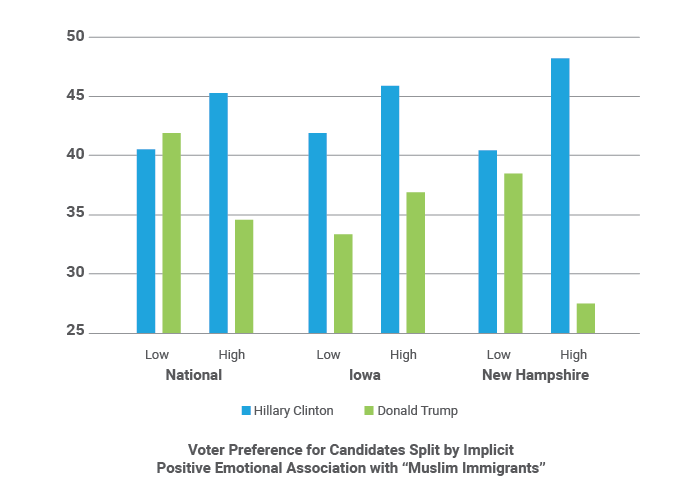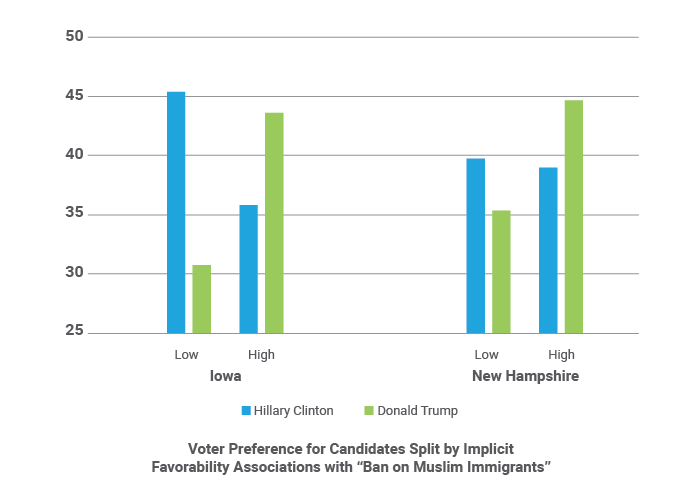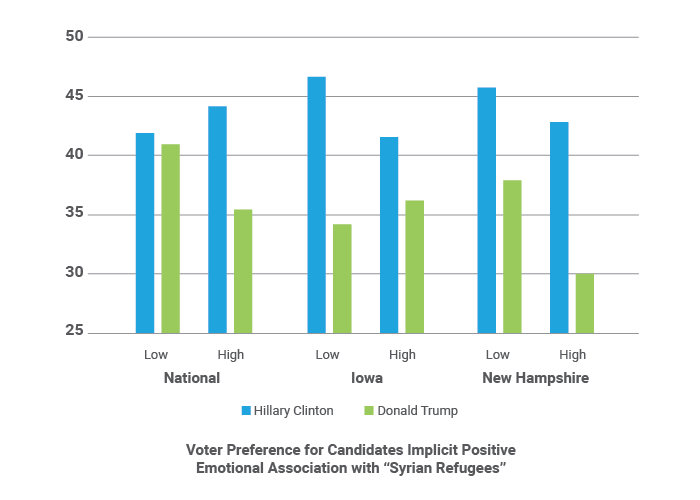Implicit Insight on the Politics of Muslim Immigration
It’s Not Just an Implicit Attitude, it’s Related to Voting Preferences!
Our recent article on the deeply held attitudes of Americans on the topic of muslim immigration has received a lot of attention. The results showed that nearly two-thirds of Americans held a negative implicit emotional association with the phrase “Muslim immigrants.”
Furthermore, while panned in the media as an unrealistic and discriminatory proposal, Donald Trump’s proposal to place a temporary “ban on Muslim immigrants” was actually favored implicitly by a majority of registered voters polled in our study on December 15 and 16.
These non-conscious attitudes are in stark contrast to what is reported from explicit questions in traditional polls. On average, what people are saying and what they are feeling do not agree.
This begs the question, “what will win in the ballot booth?“, starting with the Iowa caucuses and New Hampshire primary and onward in the progression of the Republican and Democratic nomination season.
To answer that question, we need to dig a little deeper into the conscious and non-conscious data to reveal a more complete picture of the voter decision making process.
As you will see below, these deeply held negative sentiments are not merely an implicit attitude, they are related to voter preferences for candidates.
A Better Model of Human (and Voter) Decision Making
First things first. If we’re going to make predictions on voting behaviors, and argue that implicit attitudes are relevant, we need to rely on a model that incorporates both System 1 (reason-based) and System 2 (non-conscious associative) inputs.
Unique in the industry, our Proportion of Emotion (POE) model quantifies the impact of emotion on choice and integrates both conscious and non-conscious responses into a unified algorithm to more accurately predict behavior.
We applied the POE model to voter decision making, which allows us to build head-to-head comparisons of candidates.
These voter preferences are then compared by differences in implicit attitudes toward topics and policies to reveal which non-conscious attitudes are the strongest predictors.
With this model in place we were able to determine whether attitudes toward:
- “Muslim immigrants”
- “Proposal to place a ban on Muslim immigrants”
- “Syrian refugees”
mattered in terms of who voters preferred as their candidate.
“Muslim Immigration” May be a Trump Card for Hillary
We ran analyses on voter preferences using implicit attitudes towards topics and proposals as the predictors¹. Importantly, negative attitudes toward “Muslim immigrants” related to increased likelihood to vote for Trump.
This shows that these attitudes are meaningful in terms of related to behavior, not merely unexpressed, unimportant feelings.
Interestingly, the opposite pattern emerged for Clinton. The more positive people felt toward “Muslim immigrants,” the more likely they were to vote for Hillary.
This was especially true in N.H., a state in which she is trailing Sanders, which suggests it may be a potent message point in the coming weeks.

The relationship of negative emotion toward “Muslim immigrants” and preference for Trump as a candidate carried over to favorability toward his proposal to place a temporary “ban on Muslim immigration” in Iowa and N.H. (note the relationship was not significant at the national level).
The more people favored that proposal, the more likely they were to vote for Trump.

One last thing. The bias toward groups of people and its relationship to voting preferences doesn’t end with “Muslim immigrants.”
The data showed that attitudes toward “Syrian Refugees” was also negatively related to voting for Trump.

This relationship can be framed in two ways, on average:
- The more positive you feel toward Syrian refugees, the less likely you are to vote for Trump.
- The more negative you feel toward Syrian refugees, the more likely you are to vote for Trump.
On Which Side is Your Non-Conscious Mind?
To find out, come take our Sentient Prime® implicit test:
I’d like to thank Sylvia Kinnicutt, Research Manager and Nathaniel Decker, Ph.D., and Behavioral Scientist at Sentient Decision Science Inc., for their keen design insight and analysis skills on this important research.
Market Researcher Relevant Footnote¹
One of the great strengths of implicit research technology over alternative non-conscious methods is that it produces large scale quantitative data at the individual level.
Data of this nature allows a researcher to test hypotheses using the same statistical methods that would be used on traditional conscious data from a survey.
T-tests, ANOVAs, regressions and other multivariate methods can all be used to analyze differences between groups and relationships between variables.
This should produce a sense of relief in all those market researchers who have developed deep expertise in the analysis of survey data but keep hearing the whispers of excitement around non-conscious methods.
Yes, Sentient Prime implicit association scores can be dropped into your cross-tabs right along side your data from explicit questions and can be analyzed in the same way.
Of all of the consumer neuroscience methods that provide access to non-conscious processing, Sentient Prime implicit association testing is the most easily scaled and analyzed technique.
